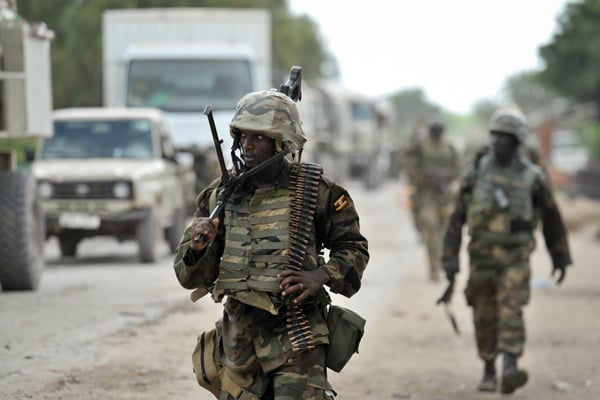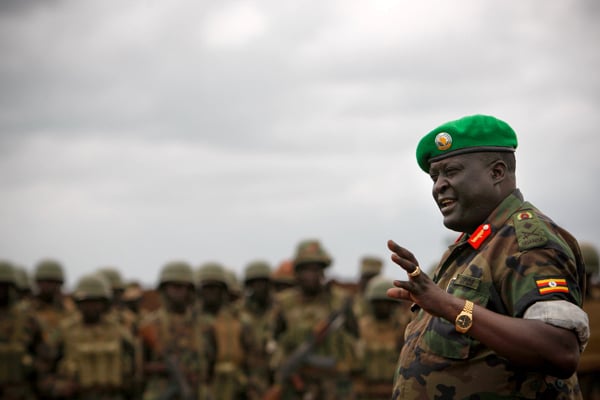Prime
Al-Shabaab: Lessons for Uganda and her allies in Somalia

UPDF personnel patrol the streets of Mogadishu, the capital of Somalia, in 2014. Uganda was the first to deploy troops under Amisom in Somalia in March 2007. PHOTOS/ FILE
What you need to know:
- The latest assault, which Gen Yoweri Museveni, the commander-in-chief of the UPDF, said would be investigated by a board led by the Chief of Defence Forces, Gen Wilson Mbadi, raises many questions as to what will happen once all foreign troops leave Somali soil. Will al-Shabaab disappear altogether or will it regroup and launch new attacks?
In March 2022, the Peace and Security Council of the African Union issued a communique detailing the mandate of the African Union Transition Mission in Somalia (Atmis). It said the new mission, which replaced the African Union Mission in Somalia, or Amisom, would continue to fight the militant group al-Shabaab and develop the capacity of the Somali Armed Forces to take over security.
The mission is setting the stage for foreign troops, which entered Somalia in March 2007, to leave in December 2024. But the extremist group the troops have been fighting for 16 years — and is widely thought to be weakened (at least by parties involved) after being pushed out of Mogadishu, the capital, and other major towns — is showing strong signs that it is alive and kicking.

Ugandan soldiers pay their last respects to their fallen colleagues in Somalia in the late 2000s.
In a deadly dawn attack that took Uganda’s military establishment by surprise, al-Shabaab last week overran a UPDF base in Bulo Marer Town, the gateway to Baraawe port city, killing an unspecified number of soldiers and destroying military hardware, including tanks.
As truth is the first casualty of war, Ugandans may never get to know the actual number of soldiers killed. Nonetheless, the attack speaks to al-Shabaab’s residual fighting spirit.
It is worth noting that the militant group has been fought by troops from six countries: Burundi, Djibouti, Ethiopia, Kenya, Sierra Leone and Uganda. (Burundi and Uganda were the first to contribute troops; Sierra Leone stopped participating in 2014.) In all, 18,586 troops are fighting in Somalia, according to information on the Atmis website.
The mission is supported by a quartet made up of powerful organisations that run the world: the UN, EU (which pays the soldiers’ stipends) and AU — plus the Federal Government of Somalia. Given that al-Shabaab does not have the luxury of superior weapons, it is surprising that the group is still able to attack foreign troops at a time it should have been totally defeated.

A UPDF commander displays weapons captured from al-Shabaab militants.
The latest assault, which Gen Yoweri Museveni, the commander-in-chief of the UPDF, said would be investigated by a board led by the Chief of Defence Forces, Gen Wilson Mbadi, raises many questions as to what will happen once all foreign troops leave Somali soil.
Will al-Shabaab disappear altogether or will it regroup and launch new attacks? Will Somali Armed Forces rein in the group when troops from five countries have not succeeded in wiping it out? If al-Shabaab is carrying out attacks as the mission is nearing its end, what will stop it from ramping up those attacks once foreign troops leave?
Mixed record
Has the mission achieved what it set out to do or has it failed? Researchers facilitated by the UN and the AU say Amisom has had some successes but also failures. The successes become even more noticeable, especially when viewed against the state Somalia was in before the first deployment.

Somalia had been without the central government since 1991 when Siad Barre, who had been in power for 21 years, was overthrown. The vacuum created by Barre’s departure triggered a civil war between clan warlords Ali Mahdi and Mohammed Farah Aideed (whose widow sought refuge in Uganda after her husband was killed in fighting in 1996).
The ensuing anarchy sucked in the UN, which launched Operation Restore Hope, and US marines. But public anger in the US was growing after Aideed’s forces shot down two Black Hawk helicopters in a battle which led to the deaths of 18 US soldiers. Angry Somalis dragged bodies of the dead soldiers through the streets of Mogadishu.
In 1994, President Bill Clinton pulled US troops out, and the UN withdrew from Somalia in March 1995. Fighting continued in the country, and a little more than a decade later, in December 2006, Ethiopian security forces intervened to back Somalia’s Transitional Federal Government against the defunct Union of Islamic Courts for which al-Shabaab, which means youth in Arabic, served as the radical youth wing.
Amisom has since tried to fix Somalia’s security problems by reducing the threat posed by al-Shabaab and other armed opposition groups while also providing security to drive Somalia’s political process and efforts at reconciliation, according to the Effectiveness of Peace Operations Network, or Epon, a consortium of more than 40 research institutions studying the effectiveness of peace operations.
Epon says that though Amisom has not played a major role in responding to Somalia’s fundamental problem — a political crisis characterised by disagreements over governance structures and interrelated armed conflicts fought over a variety of issues — it has made “considerable progress in a very difficult environment.”
It cites Amisom’s successful campaign to eject al-Shabaab from major towns across south-central Somalia. “In doing so, the mission played a major role in protecting two transitional governments, two federal governments, and two national electoral processes,” Epon says.
It adds that Amisom has created a conducive environment for numerous international actors, including the UN, to return to Somalia and that “even some of Amisom’s harshest critics concede that these positive developments would not have been possible without its efforts”.
But the mission has failed where it matters most: defeating al-Shabaab. Observers say that military means alone cannot eliminate the al-Shabaab threat and that an effective strategy requires Somalia’s federal and regional leaders to reconcile and craft a plan that prioritises political dialogue, which can result in a lasting solution.

A deserted stretch of the Bakara Market in 2011. Al-Shabaab militants once used the market as a base.
Lessons from the mission
State-building projects that are overseen by foreigners using military means rarely end in success, especially when inclusive political settlement is not part of the strategy.
In 2001, the United States and its allies entered Afghanistan, and they did everything in their power to defeat the Taliban and build a functioning democracy. But Afghanistan did not see peace and remained mired in conflict and corruption.
The insurgency that foreign troops fought for two decades showed no sign of vanishing for good. In fact, the Taliban eventually managed to launch a lightning offensive at a time the group would have been a decimated force, capturing town after town before regaining power.
According to the Associated Press, the US spent $837 billion (16 times the GDP of Uganda) fighting the war. Another $145 billion was spent on rebuilding Afghanistan. About $83 billion went to building and sustaining the Afghan army and police forces.
The human cost was also staggering: As of April 2021, the US had lost 2,448 people serving in the armed forces in Afghanistan. And 1,144 allied troops, including from other Nato member states, had been killed.
If this prize example teaches us anything, it is that foreign intervention is a costly and ineffectual way of state-building and nurturing peace and security.
Closer home, Uganda’s neighbour to the west, the Democratic Republic Congo, is effectively a playground for armed groups and has not seen peace since Mobutu Sese Seko was ousted, despite the intervention and presence of UN peacekeepers since 1998 and lately the East African Community Regional Force, to which Burundi, Kenya, South Sudan and Uganda have contributed troops.
Secrecy around casualties
Uganda has had a long history of being involved in foreign peacekeeping missions, but so far, only one has been successful: Liberia. The government deployed troops in 1994, joining Ecomog, the West African military intervention force, along with Tanzania and Zimbabwe.
Even then, Liberia did not become immediately peaceful and stable. Long after Ugandan troops had left, Nigerian and US troops had to go in to try to pacify the country. Liberia started stabilising sometime in 2005 when Ellen Johnson Sirleaf became president.

Gen Yoweri Museveni
For the Somalia mission, it is not clear what the Ugandan government will count as real success, considering that al-Shabaab is still able to mount deadly attacks.
The government has not been fully accountable to Ugandans about the mission. For example, little has been said about the human cost of the war, and Ugandans are still in the dark about the exact number of soldiers who have died in combat operations since deployment started.
If these men and women are putting their lives in harm’s way to secure Uganda, as the government claims, why is it that their deaths are not public knowledge? Isn’t the public that looks after these soldiers supposed to know and recognise those killed on the frontline as fallen heroes?
The secrecy around casualties has led to estimates that cannot be dismissed and cannot be believed either because the truth is concealed. A South African newspaper, the Daily Maverick, claimed in a 2015 article that perhaps 4,000 troops (for all troop-contributing countries) had been killed between 2007 and 2014.
And there is another problem. Not everyone agrees that Uganda is more secure than it was before deployment of its troops to Somalia. One of the stated reasons for military intervention was that troops would neutralise the threat from al-Shabaab. But in 2010, more than 70 Ugandans were killed in bomb blasts that were linked to the militant group.
Al-Shabaab’s strengths
Atmis has about 18 months to conclude, and once it is closed, Somali Security Forces are going to do what the 18,000-strong force has been doing: securing Somalia. This is going to be the litmus test of how effective Amisom and Atmis have been.
Al-Shabaab may have suffered many defeats over the past 16 years, but it remains a highly organised militant group, and the security forces will have to double their efforts if they are to do better than Amisom and Atmis.
In October 2020, the Hiraal Institute, a think tank, published a report about al-Shabaab’s financial system, and it estimated the group was collecting tax revenue of $15m (Shs56.5b) per month.

Female UPDF personnel interact with locals in Mogadishu in 2013.
“The group’s capability in tax collection has improved, and complaints about the group’s reach have been growing,” the Institute wrote.
According to Al Jazeera, al-Shabaab has also developed its own justice system even as it continues to face fire from foreign troops. Residents of Mogadishu and government officials travel to al-Shabaab-controlled areas to visit courts that can handle matters such as land disputes.
Somalis generally view the group as less corrupt than their government. The government will continue fighting al-Shabaab, but as the International Crisis Group has observed, Somali armed forces “for now are far from up to the task of keeping militants at bay”.



